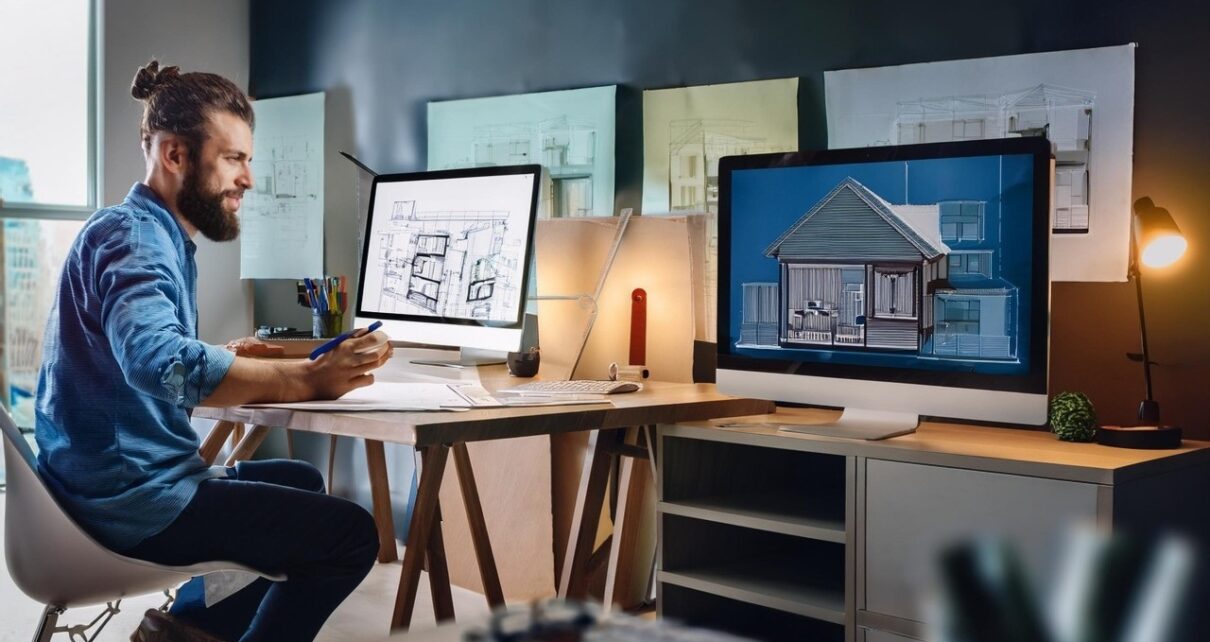Remote work methodology does not require physical presence to accomplish tasks, making it a comfortable choice for AEC professionals worldwide. According to the AIA’s Compensation Report, around 72% of architectural firms started offering full-time or nearly full-time remote work options to their employees in the year 2020.
This shift to remote work reflects the growing prevalence of remote work in the architectural industry, enabling firms to tackle large-scale projects that require collaboration across multiple locations.
In this case, remote architects, once a new phenomenon, are now a vital component of the projects that offer expertise from around the globe.
Remote management of these large projects has certain drawbacks, such as communication loss, time differences, and the need for incessant coordination.
Transcending these challenges assures project success, which can be achieved with the workflow strategies for remote architects, specifically designed to meet the requirements while working on complex projects.
Challenges in the Workflow Efficiency of Remote Architect Teams
Effective communication is the backbone of any successful architectural project. Remote architect teams face several challenges hindering their effective communication, such as a lack of face-to-face interactions leading to misunderstandings and difficulty conveying design concepts over digital platforms. Time differences also affect real-time collaboration and efficient execution.
Architectural project stakeholders, including engineers, designers, and contractors also face various coordination challenges such as tracking design changes across multiple disciplines, ensuring work consistency, and providing accuracy in the project deliverables.
However, streamlining remote work using advanced technology bridges this gap. Time tracking software helps remote teams ensure transparency and monitor project timelines, boosting the productivity of the team.
Effective Workflow Strategies for Remote Architects
Overcoming the above-mentioned key challenges, architectural practices can implement a structured workflow that facilitates efficiency and collaboration.
- Clear Communication Protocols
Clear Communication Protocols are crucial in maintaining a smooth workflow. Conducting daily stand-ups, progress meetings, and feedback sessions ensures alignment and dedication toward the projects. Moreover, using communication platforms also facilitates real-time discussions clearing doubts or misunderstandings, and maintaining transparency and accountability.
- Using Advanced Tools and Technology
Advanced technology is another effective tool in maintaining the workflow and it enables the remote architect teams to collaborate for real-time design modifications, and cloud-based software enables centralized data access and updates. AI-assisted automation helps in optimizing repetitive design tasks and improves efficiency.
- Breaking Down Project into Phases
Another suitable strategy is to break down the project into various phases which streamlines the workflow and makes the target more achievable. This is defining milestones and delivery for each phase, and then assigning specialized teams and conducting the milestone evaluations to track the progress of the project. Adjustments in the plan can be made to enhance the project execution and project delivery post monitoring the progress in each phase.
- Implementing Version Control Systems
Maintaining version control is critical to ensure accuracy in remote projects. Some tools for tracking the changes, implementing naming conventions, and timestamped revisions help in avoiding confusion, and ensuring all team members work on the most updated project version.
- Time Management and Scheduling
Time management and scheduling are vital to maintain an effective workflow. Designing flexible schedules accommodating various time zones and then utilizing project management tools for task distribution, helps in setting realistic deadlines with some buffer period for revisions and refinements.
- Regular Design Reviews and Feedback
The review sessions are fruitful in enhancing project quality. With virtual walkthroughs and critiques, engaging clients in the design process with interactive digital models, and scheduling periodic design audits ensure adherence in achieving the project goals.
- Ensuring Data Security
Data security is paramount in remote architectural services. Using some secure file-sharing platforms that use encrypted communication channels to protect sensitive project data. Establishing cybersecurity policies, including multi-factor authentication and regular security audits, helps to safeguard critical information.
Read More : How can MEP BIM Modeling Services benefit the MEP contractors
How is a Well-Defined Remote Workflow Strategy beneficial?
A structured workflow offers various advantages to architectural firms, with enhanced collaboration across the distributed teams to seamless work execution regardless of geographical location. Improved productivity is achieved with a structured workflow, boosting efficiency.
Faster decision-making is facilitated by real-time communication and cloud-based documentation, leading to quick approvals and design modifications. Cost-effective operations allow practices to reduce overhead costs.
Future of the Remote Architectural Services
The future of Remote Architecture services is driven by continuous technological advancements, with key trends including AI and automation optimizing architectural design processes. The expansion of VR and AR for client presentations and the adoption of blockchain technology in securing contract management and data integrity are other evolving technologies.
Firms targeting to refine their remote work strategies can better handle large-scale architectural projects with precision, efficiency, and innovation. To simplify the workflow, AEC firms can integrate hiring models that provide access to trained professionals who are equipped with the knowledge of real-time collaboration tools, adapt to the company’s cultural dynamics immediately, and generate results from the onset of joining. One such resource model is DRM solutions offering tailored remote architectural services, expediting growth and synchronized working throughout the project execution with global industry experts.
Conclusion
The evolution of remote architectural services unlocks immense potential in fully leveraging the benefits of remote work, prioritizing structured and efficient workflow strategies. From clear communication protocols to adapting advanced technology to ensure data security and effective project management, a robust remote work model is crucial.
Firms navigating these challenges gain a competitive edge by delivering high-quality large-scale projects efficiently and cost-effectively.
The integration of AI, blockchain-based contract management, and virtual reality-driven client presentation enhances remote architectural services. Companies remain adaptable and invest in continuous learning to keep up with technological advances.
The success of remote architects and engineers hinges on their ability to adapt, collaborate effectively, and then leverage digital technology for better precision and project execution.
Shifting towards remote architecture isn’t a temporary trend but a transformative movement shaping the future of the AEC industry. Firms investing in workflow optimization, digital transformation, and global talent acquisition will be positioned at the forefront of the evolving landscape of architectural practice globally.




